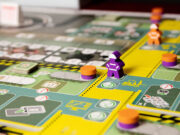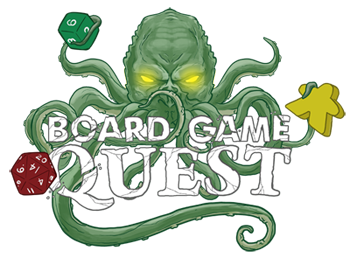 Sandbox-y Euro games are everywhere these days, and though I want to love them all, I find myself cold on most of them. I like my sandbox to be deep without many rules, sprawling without many components, and difficult without feeling constrained. Oh, and I need it to be almost entirely card-based. How hard can it be to satisfy that very reasonable list of contradictory demands?
Sandbox-y Euro games are everywhere these days, and though I want to love them all, I find myself cold on most of them. I like my sandbox to be deep without many rules, sprawling without many components, and difficult without feeling constrained. Oh, and I need it to be almost entirely card-based. How hard can it be to satisfy that very reasonable list of contradictory demands?
The latest such game to arrive in my home is Rome: Fate of an Empire, a solo deck-building game that fits in a VCR box. Theoretically, it ticks all my boxes, but how does it shake out in practice?
Rome: Fate of an Empire is a deck-building game for 1 player that takes around 60-90 minutes to play.
Gameplay Overview:
Rome: Fate of an Empire can be roughly split into three parts: your empire, your deck, and the market. Your empire is represented by a 5×5 grid, and aside from the central Capital, these spaces all start out undeveloped. You will place developments onto these spaces to generate VPs, and to build a tableau of actions. Developments produce resources and provide special abilities, but these actions can only be activated if your character is physically at that location. Developments also need to be built using attribute points (or AP), which is where your deck comes into play.

On each turn you draw a hand of attribute cards, which can be played in a variety of ways. Each card has an action on it (which can be boosted by spending a matching resource), and actions usually provide one of four types of AP. In addition to building developments, AP can be spent to fight barbarians studded around the map, broker deals to generate resources over time, and even cycle out unwanted cards in the market. You can also play attribute cards to generate movement across your empire, or even to generate a single AP of any type.
Of course, you won’t get far in Rome without spending some gold at the market. The market holds a row of development cards and a row of advanced attribute cards, and you can spend gold on your turn to purchase cards. Developments are placed in front of you once purchased, and cost additional gold every turn until they are finally built, whereas advanced attributes are placed on top of your deck to be used next turn.
After four rounds, you tally up all VPs earned from built developments and conquered barbarians. If you manage to complete all the Edicts assigned to you at the start of the game, and surpass the VP requirement denoted by those Edicts, you win.

Game Experience:
Rome: Fate of an Empire is onerous, obtuse, and overwrought. For my entire first game, I had no idea what I was supposed to do, how I was supposed to do it, or whether I was doing it right. Accomplishing anything at all is a multi-step process, and there are so many overlapping considerations as to be genuinely paralyzing at times. None of this is helped by a pretty terrible rulebook, which does a bad job explaining its core concepts and a worse job providing clarity on crucial timing considerations. It’s hard to imagine any juice being worth this much of a squeeze… and yet, Rome: Fate of an Empire really is that good.

I love how the map works. You can only access the developments you can move to, and you have a limited number of actions each turn. These are trivial concerns to start, but quickly become a dense knot of difficult decisions. Placing new developments is equally tricky, because you have to weigh immediate value against long-term synergies. You feel constrained by your leader’s physical location, which provides an amazing sense of place within your empire.
The card play is similarly thorny. There are four ways to play every card, and the best way to play each one can be an excruciating choice, because rounds last until your deck is empty. You want to play cards to make things happen, but you also want to hold on to them to extend the round. This intersects with the map play in interesting ways; you need cards to build developments, which you need to generate resources, which you need to boost your cards… everything feeds on and is fed by everything else. It can be exhausting, but it’s also exhilarating when you manage to line everything up perfectly in a turn.

The puzzle stays fresh every game, too, thanks to the variety on offer. You’ll buy and develop different cards every game due to the random markets, but the biggest drivers of replay value are the Edicts and the different characters you can play. Edicts push you towards different victory conditions, and each character has different game-breaking strengths and catastrophic weaknesses. Applying each character’s toolset to a specific group of Edicts forces you to approach every game from a different angle.

Final Thoughts:
Rome: Fate of an Empire is the only game I’ve ever played to give me a migraine. It took me over a month to get it back to the table after my first game… then about a week for the next game, then less than a day, and now I always want to play multiple games in a row. There is a lot to learn and a lot to keep track of, and you’ll likely feel wrung out by the end of it–but if you’re up for it, Rome: Fate of an Empire is a phenomenal sandbox to play around in.
Final Score: 4.5 Stars–an excellent solo deck-builder and tableau builder, with a monumental learning curve.
 Hits:
Hits:
• Quintessential “big game in a small box”
• Map creates a sense of place in your empire
• Edicts and leaders produce a ton of replay value
• Easy to tweak game length and difficulty
Misses:
• Very difficult to learn
• Rule book lacks clarity
• Complexity can lead to paralysis and exhaustion






















There’s a playthrough by the designer that helped me get the game figured out a bit better. The AP is definitely an obstacle with this one, but it’s still a lot of fun.